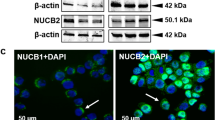Summary
The artificial sweetener saccharin inhibits binding of epidermal growth factor (EGF) to cultured rat pituitary tumor cells (GH4C1 cells). Saccharin also causes morphological alterations in these cells, resulting in pronounced elongation, stretching, and firmer attachment of cells to the culture dishes. These alterations in cell shape are similar to those observed after treatment of GH4C1 cells with EGF and with thyrotropin-releasing hormone (TRH), both of which enhance prolactin (PRL) production in these cells. After assaying for PRL in saccharin-treated cultures, it was observed that this sweetener is also capable of stimulating PRL production two-to sixfold in a dose-dependent manner. Enhancement of PRL production can be observed at 0.5 mM saccharin, yet this is 10 times less than the saccharin concentration required to alter cell shape. These effects of saccharin on cell morphology and on PRL production are reversible in GH4C1 cell cultures. When added to cultures along with maximal concentrations of EGF or TRH, the effects of saccharin on PRL production are additive, suggesting that the actions of saccharin are mediated by a somewhat different pathway from that of the peptide hormones. Pulse labeling studies indicate that the enhancement of PRL production is highly specific inasmuch as saccharin was found to decrease the overall rate of protein synthesis in these cells. Saccharin also causes a decrease in the rate of DNA synthesis under these treatment conditions. Mitomycin C, which similarly inhibited DNA synthesis, had no effect on cell morphology or PRL production.
Similar content being viewed by others
References
Aggeler, J.; Frisch, S. M.; Werb, Z. Changes in cell shape correlate with collagenase gene expression in rabbit synovial fibroblasts. J. Cell Biol. 98: 1662–1671; 1984.
Boyland, E. Saccharin: from carcinogen to promoter. Nature 278: 123–124; 1979.
Boynton, A. L.; Whitfield, J. F. Stimulation of DNA synthesis in calcium-deprived T518 liver cells by the tumor promotors phenobarbital, saccharin and 12-0-tetradecanoylphorbol-13-acetate. Cancer Res. 40: 4541–4545; 1980.
Brennessel, B. A.; Biswas, D. K. Defective thyroliberin-induced prolactin synthesis and release in a hybrid GH strain. Mol. Cell. Biochem. 63: 67–73; 1984.
Brennessel, B. A.; Oldham, E. R. Phytohemagglutinin alters cell morphology and decreases prolactin production in GH-cells. Exp. Cell Res. 153: 528–533; 1984.
Colburn, W. A.; Bekersky, I.; Blumenthal, H. P. Dietary saccharin kinetics. Clin. Pharmacol. Ther. 30: 558–563; 1981.
Johnson, L. K.; Baxter, J. D.; Vlodavsky, I.; Gospodarowicz, D. Epidermal growth factor and expression of specific genes: effects on cultured rat pituitary tumor cells are dissociable from the mitogenic response. Proc. Natl. Acad. Sci. USA 77: 394–398; 1980.
Kakizoe, T.; Komatsu, H.; Niijima, T.; et al. Maintenance by saccharin ofmembrane alterations of rat bladder cells induced by subcarcinogenic treatment with bladder carcinogens. Cancer Res. 41: 4702–4705; 1981.
Lee, L. S. Saccharin and cyclamate inhibit binding of epidermal growth factor. Proc. Natl. Acad. Sci. USA 78: 1042–1046; 1981.
Lee, L. S.; Weinstein I. B. Mechanism of tumor promotor inhibition of cellular binding of epidermal growth factor. Proc. Natl. Acad. Sci. USA 76: 5168–5172; 1979.
Lee, L. S.; Weinstein, I. B. Tumor-promoting phorbol esters inhibit binding of epidermal growth factor to cellular receptors. Science 202: 313–315; 1978.
Lowry, O. H.; Rosebrough, N. J.; Farr, A. L.; et al. Protein measurement with the Folin phenol reagent. J. Biol. Chem. 193: 265–275; 1951.
Osborne, R.; Tashjian, A. H., Jr. Tumor promoting phorbol esters affect production of prolactin and growth hormone by rat pituitary tumor cells. Endocrinology 81: 1164–1170; 1981.
Osborne, R.; Tashjian, A. H., Jr. Modulation of peptide binding to specific receptors on rat pituitary cells by tumor-promoting phorbol esters: decreased binding of thyrotropin-releasing hormone and somatostatin as well as epidermal growth factor. Cancer Res. 41: 4375–4381; 1982.
Pantarotto, C.; Salmona, N.; Garattini, S. Plasma kinetics and urinary elimination of saccharin in man. Tox. Lett. 9: 367–371; 1980.
Schonbrunn, A.; Krasnoff, M.; Westendorf, J. M.; et al. Epidermal growth factor and thyrotropin-releasing hormone act similarly on a clonal pituitary cell strain. J. Cell Biol. 85: 786–797; 1980.
Sweatman, J. W.; Renwick, A. G.; Burgess, C. D. The pharmacokinetics of saccharin in man. Xenobiotica 11: 531–540; 1981.
Tashjian, A. H., Jr.; Hoyt, R. F., Jr. Transient controls of organ-specific functions in pituitary cells in culture. In: Sussman, M., ed. Molecular genetics and developmental biology. Englewood Cliffs, NJ: Prentice-Hall; 1972: 353–387.
Tashjian, A. H., Jr.; Levine, L.; Wilhelmi, A. E. Studies on growth hormone by microcomplement fixation. Ann. NY Acad. Sci. 148: 352–371; 1968.
Trosko, J. E.; Dawson, B.; Yotti, L. P.; et al. Saccharin may act as a tumor promotor by inhibiting metabolic cooperation between cells. Nature 285: 109–110; 1980.
Author information
Authors and Affiliations
Additional information
This investigation was supported by a Faculty Research Grant from Wheaton College
Rights and permissions
About this article
Cite this article
Brennessel, B.A., Keyes, K.J. Saccharin induces morphological changes and enhances prolactin production in GH4C1 cells. In Vitro Cell Dev Biol 21, 402–408 (1985). https://doi.org/10.1007/BF02623471
Received:
Accepted:
Issue Date:
DOI: https://doi.org/10.1007/BF02623471




